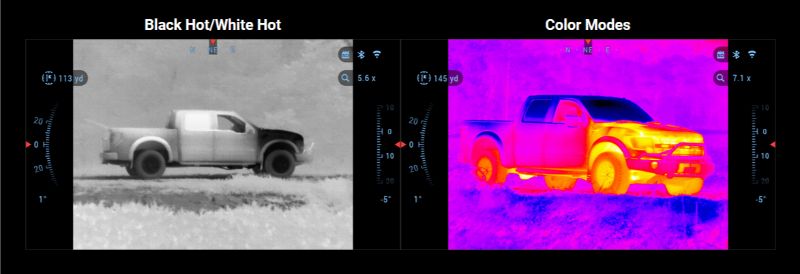This article contains affiliate links. We may earn a small commission if you purchase via these links.
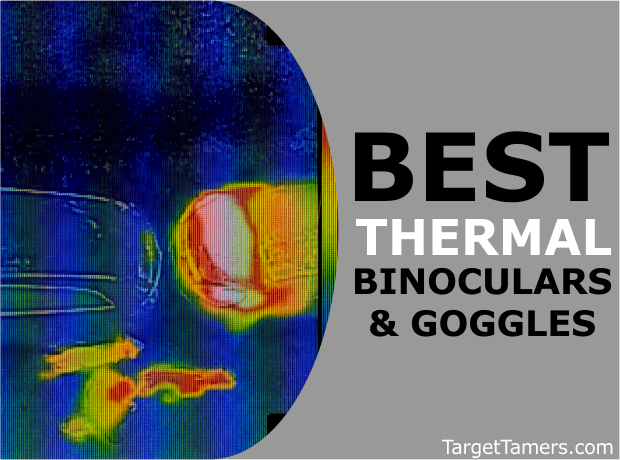
Can't see in the dark?
Can't see between thick timber?
Can't see far enough to determine if it's your target?
There's a treatment for that, and we have the right prescription for you.
Thermal vision has been the cure to improving vision for all types of professions, sports, and recreational activities. However, you must be pretty hardcore or have deep pockets if you're buying thermal imaging just for fun.
Since it's a costly technology to manufacture, and there are only a handful of legitimate manufacturers that offer it, you must research your potential buy before you front up the cash.
That's why we have a lineup to help you figure out what goggles are absolute buys, which are the best thermal binoculars and the ones will stay on your short wish-list for another day.
Get treated here for your lack of vision and never go sightless again!
Why Trust Us?
After hundreds of hours of hand-testing thermal binoculars in the field and at the range, and thousands more hours researching and writing about them, we feel we earn the title of experts when it comes to optics!
We purchase as many of the optics for our tests as possible, and run them through their paces to make sure they will perform at the range and in the field.
Our combined decades of experience from zoom and focus, to big game hunting and competitions has been integral in putting together this round-up of the best thermal binoculars, bi-oculars & goggles.
Get the inside scoop on how we test optics here.
8 Top Thermal Goggles, Binoculars & Bi-Oculars
| IMAGE | PRODUCT | DETAILS | |
|---|---|---|---|
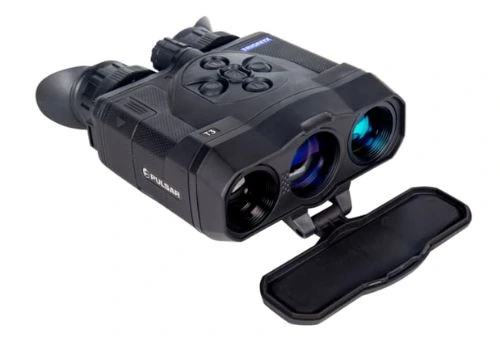 | Pulsar Trionyx Multispectral Fusion |
| CHECK PRICE |
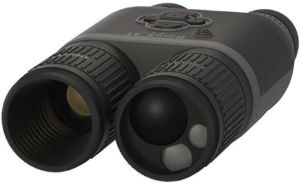 | ATN Binox 4T 640 1-10X |
| CHECK PRICE |
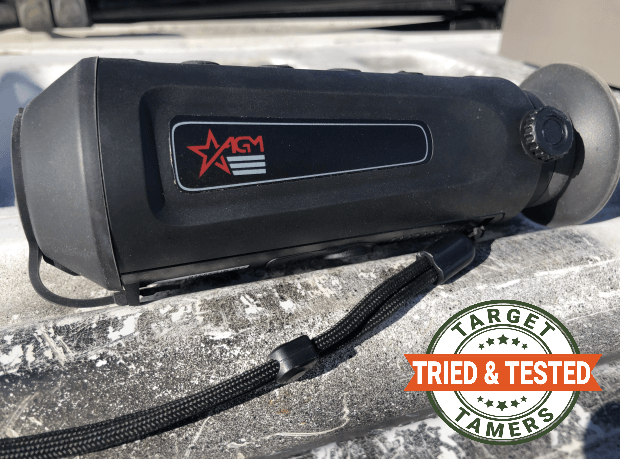 | AGM Asp-Micro TM160 |
| CHECK PRICE |
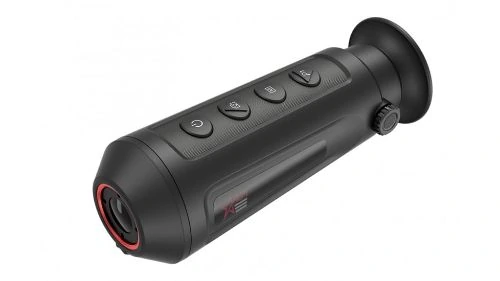 | AGM Taipan TM15-384 |
| CHECK PRICE |
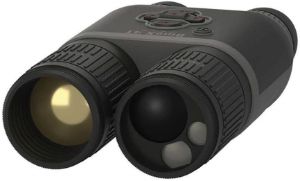 | ATN Binox 4T 640 2.5-25X |
| CHECK PRICE |
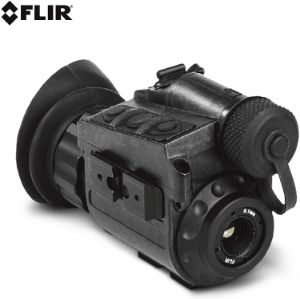 | FLIR Breach PTQ136 |
| CHECK PRICE |
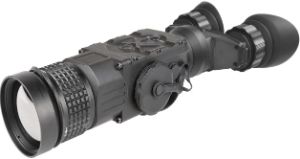 | AGM Cobra TB50-336 |
| CHECK PRICE |
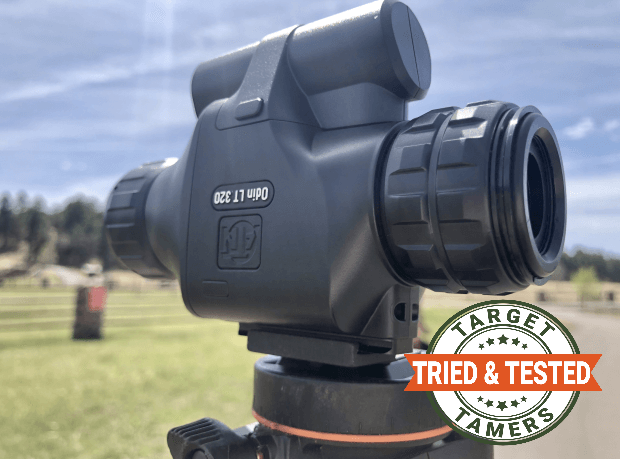 | ATN Odin LT 320 |
| CHECK PRICE |
Night and thermal vision have long been associated with the U.S. Military and law enforcement. One movie that portrays its very use is Schwarzenegger's "Predator" of '87.
While soldiers and SWAT agents may have had the only access to thermal technology in goggles and other devices in the past, it's now open to the commercial market.
Although it's very expensive to buy thermal night vision, it can be used for more than warfare, raids, and covert operations. Hunters are maximizing this tech in the field to track down game, to control nocturnal varmint and pest populations, and scout the area for deer hot spots.
Campers and hikers can appreciate thermal imaging tech to see what's howling or grunting around the grounds and trails, and preppers will increase security measures with thermal vision to spot threats and breaches to their compounds.
So, how does thermal night vision work? In a nutshell, the device emits IR (infra-red) energy. It records the temperature data of everything within the target scene to create a thermogram. The thermogram goes through a series of processes to produce an image of the target scene onto a screen.
The screen will display the target scene in multiple color options (depending on the device) to identify living targets like animals and humans from non-living targets like buildings and vehicles.
Now knowing how thermal imaging briefly works and who it can work for, let's get into what thermal vison goggles and binoculars are available to you today.
Top 8 Best Thermal Goggles & Binocular Reviews
1. Best Overall: Pulsar Trionyx Multispectral Fusion
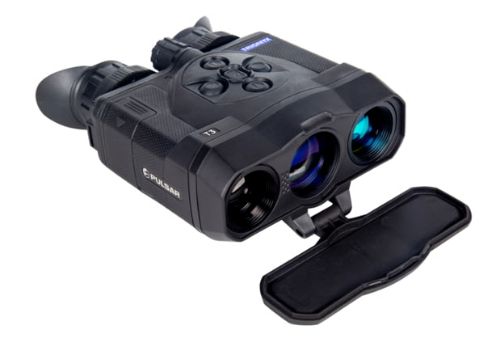
Fusion technology is the blending of thermal imaging and night vision in one device. Pulsar releases the Trionyx Multispectral Fusion binoculars with this new applied science. Though pricey, it’s still not as expensive as thermal imaging was when it first became available to the civilian market.
Pros:
- Binoculars
- Fusion technology
- Long-range detection
- WiFi integration
- Quick-change batteries
Cons:
- Not helmet compatible
Though someone somewhere may come up with a solution to mount this state-of-the-art optic, it’s not suited to helmet mounting. As a binocular with two eyepieces and minimum 2.5x magnification, it’s not made for goggle use.
Its specs include a 384x288, uncooled, 17-micron thermal sensor and 1280x720, 50Hz CMOS digital night vision sensor. In night vision mode complete with a built-in IR illuminator, it has 2.5-10x magnification, 400 m detection range, and a FOV of 15.4°. It also has high-resolution detail processing for positive target identification of either a perp or to count tines.
In thermal mode, you have 3.5-14x magnification, 1000 m detection range, and a FOV of 9.1°. The Trionyx separates thermal and night vision modes to allow for user preference, however, the multispectral overlay mode is a combination of both.
The only differences between the available models are the IR illuminators. The T3 has a long-range 850 IR while the T3i has an invisible 940 IR.
It’s IPX7 waterproof and submersible which is impressive for an electronic device. It has 16gb of internal memory storage for image capture and video recording, and it also has WiFi compatibility to iOS and Android devices for the Stream Vision 2 app.
For the power source, the Trionyx requires a TPS 7 battery unique to Pulsar’s Multispectral Fusion binoculars. It’s external, rechargeable, and provides more than six hours of continuous operation. With its interesting blend of multi-channel thermal and night vision tech, it’s a unique and futuristic binocular that may start the trend of a new breed of sports optics.
2. Best Thermal Binocular for the Money: ATN Binox 4T 640 1-10X

The Binox 4T is ATN's brand-new series of thermal imaging binoculars. With them, you'll never have an excuse to go blind on the job or in the night hunt again. Smarten up your surveillance and hunting techniques with the Smart HD binoculars.
Pros:
- 4th Gen sensor
- 1x magnification
- Laser rangefinder
- BIX technology
- Dual Stream Video
Cons:
- Not head mountable
This model was picked as a favorite for its 1-10x magnification. It comes with a soft-carry case and neck strap to be worn like binoculars, but with 1x power, can it be mounted to head or helmet gear? We reached out to ATN and confirmed that this is not head/helmet capable.
It has ATN's ultra-sensitive next gen sensor with 640 x 480 resolution. With its power range and sensor configuration, you can detect targets at 830 m, recognize at 350 m, and identify them at 225 m.
That's outstanding ranges for thermal night vision, and as the smallest model in the Binox 4T series, you know it only gets longer and better with the higher configurations.
The Binox also has a built-in laser rangefinder that provides distance measurements to targets up to 1,000 yards. BIX (Ballistic Information Exchange) technology allows your smart HD binoculars to communicate with other ATN smart devices, specifically with the smart riflescope to provide holdover information for long-range shots.
As a modern device, it also allows for Dual Stream Video that records to the micro SD card while streaming through your device such as a smartphone. Of course, to have this feature, it connects via WiFi to your phone.
Other top-notch features include an adjustable IPD, long-lasting battery life of 16+ hours, a weather-resistant build, and other digital features we're sure you'll find plenty of use for. It's an ATN everybody - it's packed with the works or it's not worth making at all.
3. Best Budget Option: AGM Asp-Micro TM160
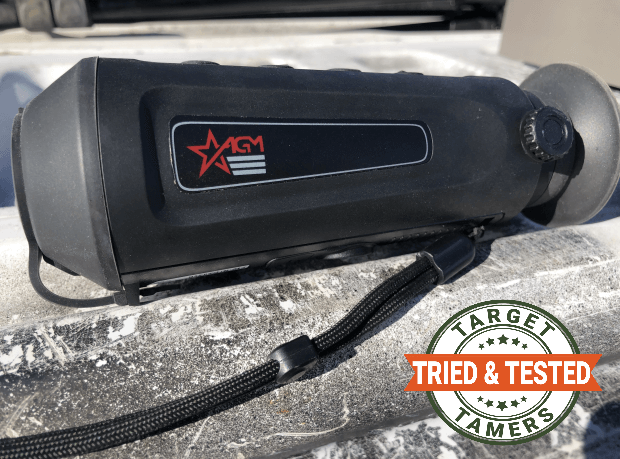
The Asp-Micro TM160 is a monocular, but due to the threading on the underside of the body, it can be used as makeshift goggles when head and helmet mounted - we tested! It can be considered cheating, but this is hands-free thermal imaging on a budget.
Pros:
- Price
- Can be helmet mounted
- Hot Tracking
- WiFi
- Close-range
Cons:
- Monocular
The Asp-Micro core is as simple as it gets for thermal imaging with many features to provide value. It has a vanadium oxide uncooled thermal core with a 25 Hz sensor and resolution of 160x120. It does not perform like more expensive alternatives, but for starter thermal imaging, the price can’t be beat.
With tripod threading, it can be connected to a J-arm and then connected to a mount to hook to a shroud. The threading point is mid-way through the body. You will need a mount with enough forwards and backwards adjustment to get the right eye relief, so it’s not forced into your eye socket (we speak from experience here!).
It has 1x magnification, though it may still be difficult to achieve maximum mobility with hands-free operation. It has digital 2x, 4x, and 8x zoom. It’s WiFi compatible for user-control through the smartphone app to capture still images and record video.
Features include Highest Temperature Tracking (Hot Tracking), Distance Measuring, Auto, Manual, and External Correction (FFC calibration), and four palette modes, Fusion, White Hot Black Hot, and Hot Red.
The internal, rechargeable battery provides 10 hours of runtime - we ran it down multiple times during testing to check. Though it has standby mode, it’s best to manually power it down to conserve battery life after use. It’s a close-range monocular with detection ranges out to 250 yards on humans and identification at 50 yards. Larger targets like vehicles will be much further (611 yards).
Though it’s a monocular for one eye, it still provides hands-free benefits when mounted. For the money, the Asp-Micro is the best thermal goggles alternative available.
4. Best Thermal Goggle for Hunting: AGM Taipan TM15-384
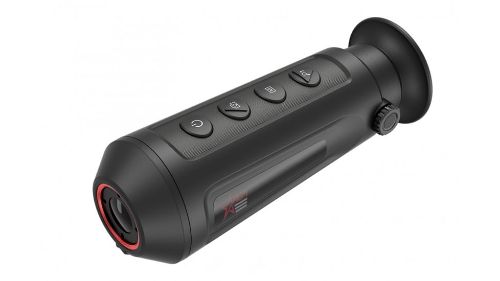
AGM has a large assortment of thermal imaging devices, and one of the more popular options is the Taipan TM15-384 monocular. Though a monocular, it’s suited to helmet mounting for hands-free goggle use.
Pros:
- Price
- Larger display
- WiFi
- Multiple features
- Lightweight
Cons:
- Monocular
As a monocular, it’s best use is as a handheld unit, however with the tripod threading on the body, it can be equipped for helmet mounting. With the appropriate parts, you can achieve hands-free, goggle-like use.
The Taipan TM15-384 is a marketable thermal because it has an attractive price point below $1500. It’s affordable, and therefore buyers will find ways to maximize its use. Whether it’s mounted or used as a handheld, it has 1x magnification for a wide FOV of 17.5° - 13.1°. The screen size of 0.4” is on the larger side versus the 0.2” of Taipan and Asp-Micro alternatives.
It has digital 2x, 4x, and 8x magnification, distance measurement, and WiFi Hotspot to capture images and video recording on your phone. You can perform FFC calibrations, Hot Track the hottest heat signature, and switch between Fusion, White Hot, Black Hot, and Red Hot palettes.
The thermal core has a 12-micron, 50 Hz, 384x288 resolution sensor, and a 710-yard detection range that is ideal for hog and coyote hunting given its price point. The Taipan has an internal rechargeable battery that provides up to 7.5 hours of runtime. Given that it’s 0.64 lbs in weight, it’s a lightweight optic to have mounted to your head for extended periods of time.
Because few have the coin to buy thermal imaging that runs into the thousands of dollars, the AGM Taipan is a salable stand-in for moderate budgets.
5. Best ATN Thermal Binoculars: ATN Binox 4T 640 2.5-25X

Sometimes you need a lot more extra reach and you need a lot more power to get you there. In this case, bigger is better.
Pros:
- Price
- High magnification
- 4th gen sensor
- Digital features
- Laser rangefinder
Cons:
- Heavy
The Binox is heavy at 2.5 lbs, but considering it has a true-to-form binocular construction, its extra weight is justified against the lighter weight bioculars we've seen in this lineup. Noticeably, it's very long at 9.4", but we think ATN did well in providing a unit that resembles daytime binoculars for a more aesthetically-pleasing design.
This model has extremely high magnification of 2.5-25x. Having such high power would be useless if it wasn't paired with a highly-sensitive 4th gen sensor with 640 x 480 resolution and a 60Hz refresh rate.
This Binox 4T also has the longest detection, recognition, and identification ranges of the entire series of 1950 m, 850 m, and 475 m. To maximize use of these ranges, it also has a built-in laser rangefinder - not a stadiametric one. The rangefinder can provide distances to targets up to 1000 yards with -/+1 yard accuracy.
Use these stats with its BIX (Ballistic Information Exchange) tech to get you dead-on with provided holdovers on your ATN smart scope. Don't have one? You can download their ballistics app and still use your thermal binoculars with your regular glass scope - nice!
With 16+ hours of operating use, it's one of the longest lasting thermals you can buy. It's also compatible with external battery packs.
A new feature to thermal imaging devices is dual live streaming. It's the ability to record with the included micro SD card and stream your very own live action hunt or sting simultaneously to those behind the screen.
ATN hits it out of the ball park with their thermal binoculars and is our #1 ATN pick!
6. Best Thermal Monocular for Law Enforcement: FLIR Breach PTQ136 Review
Yes, the PTQ135 is a monocular, but it's so much more than that. As a multi-functional device, these count as the best thermal goggles for police, security, and professional use.
Pros:
- Price
- Multi-functional
- Head-mountable
- 1x magnification
- Compact/lightweight
Cons:
- Battery life
The PTQ136 can only function in short spurts of 90 minutes at 68°F (20°C). If you ditch the recording feature and only use the monocular to glass the scene, you might be able to stretch a little more time out of it. But, you may want to carry around an extra CR123A lithium battery just in case.
As a monocular, it can be used free-hand, but with its 1x optical magnification, it makes it the perfect set of thermal night vision goggles especially for nighttime use. Mounted to head/helmet gear, you can use one through the thermal and use your other eye for natural vision.
Night blindness shouldn't be an issue since the PTQ136 has adjustable brightness settings to play around with for comfort and the best viewing image.
With a fast 60 Hz refresh rate, decent 320 sensor, and 1-4x digital zoom, you'll be able to follow targets and keep a close-eye on what they're up to. But, you must be aware that the Breach thermal night vision monocular is designed for close-range use.
You may be able to see human-sized targets at 200 yards and clearly see bunnies at 100 yards.
Its monocular design allows the thermal imaging device to stay compact at 5.5 x 2.7 x 1.9" and lightweight at 7.4 ounces. It even comes in lighter in weight than many night vision alternatives.
It has a 3-button operation interface which are stiff to depress, but it adds to the device's durability and ruggedness so there are no accidental changes to your settings. It has a fast start-up time of less than 1.5 seconds, and it also has multiple color palettes to switch through for changing conditions.
Of course, pictures and video recordings come as a standard feature on the Breach.
No-one will breach the perimeters when you're equipped with Breach thermal goggles. Although it's law enforcement grade quality, the PTQ136 will be a valuable asset to any civilian looking to enhance their defense and security measures.
Better yet, it has the best price you can find for thermal night vision tech.
7. Best Civilian Thermal Binoculars: AGM Cobra TB50-336 Review

AGM Global is a new manufacturer of optics, but the collaboration between its owners bring decades of experience to the table. The Cobra is their series of thermal imaging binoculars that they've served up on a silver platter.
Pros:
- Biocular
- Fog/waterproof
- Integral Picatinny rails
- 60 Hz refresh rate
- Lightweight/compact
Cons:
- Price
The TB50-336 is the smallest Cobra of the lot with its 336 sensor and 50 mm aperture. It has one objective lens because it's a thermal biocular. It's been built with a FLIR Tau 2 17 micron sensor with 800 x 600 display resolution and a 60 Hz refresh rate. Optical magnification is 2.9x and it has digital zoom of 2x and 4x.
The biocular is 11.3 x 4.2 x 2.3" in size and weighs almost 2 lbs. Having a solid body, it's tripod mountable. It also has built-in Picatinny rails on its body to allow attachment of additional accessories. You can also buy an external module for it to connect it to WiFi, a wireless remote control for easy execution in the field, or a 640 x 480 HD Recorder.
As a biocular versus a monocular, it can be easier to use for longer periods of time and it allows for the use of two eyes for more data input from the single objective lens. Both the eyepiece and objective lens are adjustable, there are multiple color palettes (White Hot, Black Hot, Rainbow, and more), and the entire unit is waterproof and has been nitrogen-filled.
Unfortunately, the Cobra runs on two CR123A batteries, either lithium or rechargeable, but will only provide up to 4 hours of operation. With use of a 5V power bank via USB connection, or a 6V extended battery pack, you can have up to 12 hours of use.
Like all thermal night vision devices, the Cobra doesn’t come cheap. But, to have the best, you must pay for it. It's often said, "You get what you pay for."
8. Best ATN Thermal Monocular: ATN Odin LT 320 2-4x
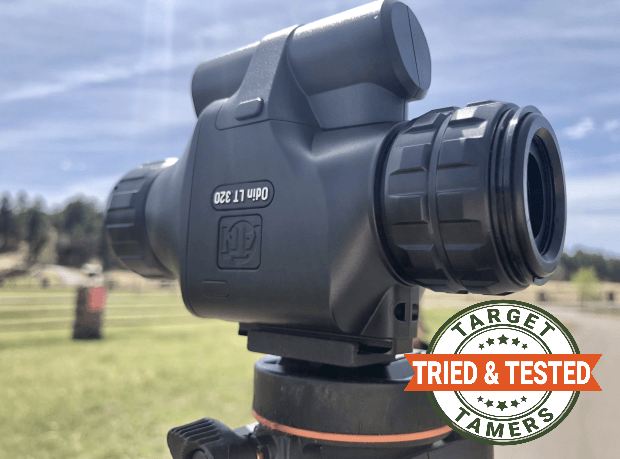
Most of ATN’s monoculars are designed primarily for handheld use, but the Odin LT is different. Though excellent in the hand, it was constructed with ergonomic head and helmet mounting capabilities for maximizing monocular versatility in the field.
Pros:
- Magnification
- Mounting options
- Mid-range detection
- Hi-res display
- Compact/lightweight
Cons:
- Battery life
The Odin LT doesn’t have the greatest out-the-door price tag and is considered expensive given cheaper alternatives in the market. However, the primary difference is its dedicated dovetail mounting rail for head and helmet mounts. Conveniently, ATN has a universal helmet mount kit sold separately that makes for uncomplicated mounting of the Odin LT.
The first thing to note is that the Odin monoculars are magnified. The lowest powered version is the Odin LT 320 2-4x with human detection ranges out to 535 meters and identification at 230 meters. Given that it’s magnified, it’s not intended to be used while mounted for navigation and mobilization. It’s intended for stationary observation. I found the best way to use the Odin is to flip it down to observe with hands-free operation and then flip it up once you’re done and get back on the move.
Though ATN is well-known for video recording, image capture, distance measurement, and WiFi, this monocular is as simple as it gets. It does without all the adornment of embellished accoutrements. It simply has White and Black Hot palettes, a High-Res 1280x960 display, and water-resistant body.
I can confirm that the stunning resolution makes up for the lack of other embellishments. My digiscoping (which you can check out in the video above) does not do justice to the quality of the Odin's resolution.
Lacking in power-hogging features, it’s a disappointment that it still has a poor runtime of 2.5 hours with a single CR123A battery. ATN has a rechargeable battery pack sold separately to double the battery life.
The Odin LT comes with a 3-year warranty, its use is streamlined to those who simply want thermal imaging for mid to long-range distances, and the versatility to head mount it. More versatility means more thermal imaging in every application.
What to Look for in a Thermal Device
Take this opportunity to learn the ins and outs of what thermal vision can do to benefit your job, hunting style, and outdoor activities. Knowing the difference between the types of night vision goggles available, how thermal differs from night vision, and what features you must know about will ensure confidence in your buy.
There's no room for buyer's remorse when you're about to hand over large amounts of cash!
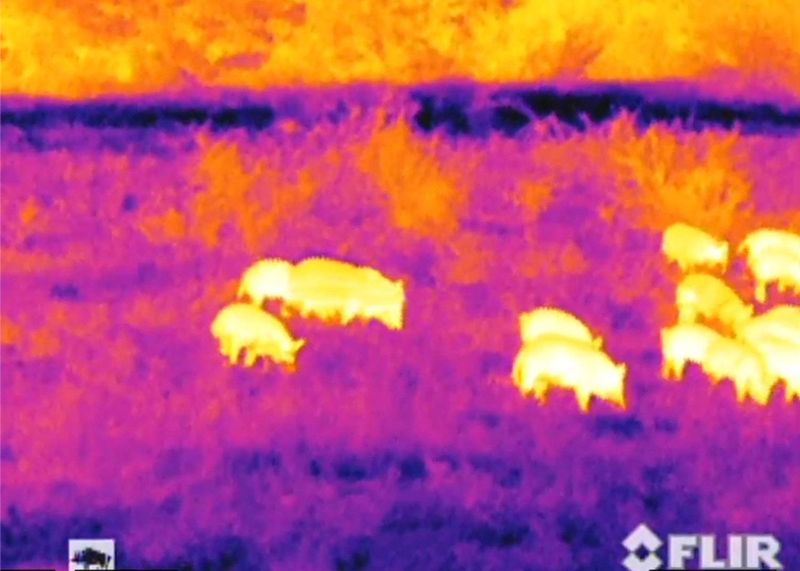
Thermal Vision VS Night Vision
True night vision optics are passive devices that require ambient light to work. They may have a shorter detection range versus thermal optics, but their recognition range is far superior to thermal because of its ability to show details like facial features, clothing, and other details similar to what you would see with natural vision.
Thermal vision, as mentioned earlier, is an active device that electronically records and displays temperature data to differentiate living targets from non-living targets in both daylight and night. You cannot see details like that of night vision, but you can detect even the smallest body part or obscured target with thermal.
You can get more details about thermal imaging technology and how it compares to night vision in our comparison guide here.
Thermal Goggles VS Thermal Binoculars
Same thing. The terms, "goggles" and "binoculars" are used interchangeably in both night and thermal vision industries. However, there are some differences to tell them apart when you need specific features for your needs.
Goggle features:
- 1x magnification
- Must be helmet/head mountable
- May include head mount/goggle kit
- May include 1x monoculars, binoculars, and bioculars
Binocular features:
- Dual tubes
- Magnification
- May include biocular design
- Not recommended for use as goggles due to magnified optics
Thermal Binoculars VS Thermal Bioculars
| Product | Optic Type | Price Range |
|---|---|---|
| Pulsar Trionyx Multispectral Fusion | Binocular | Under $300 |
| ATN Binox 4T 640 1-10X | Binocular | Under $5000 |
| AGM Asp-Micro TM160 | Monocular | Under $400 |
| AGM Taipan TM15-384 | Monocular | Under $1500 |
| ATN Binox 4T 640 2.5-25X | Binocular | Under $5000 |
| FLIR Breach PTQ136 | Monocular | Under $2500 |
| AGM Cobra TB50-336 | Bi-Ocular | Under $6000 |
| ATN Odin LT 320 2-4X | Monocular | Under $1300 |
It's easy to get mixed up by the two designs since the omission of one letter can often be mistaken for a typo, however, their different objective bell constructions are the tell-tale feature that sets them apart.
Binoculars obviously have dual tubes that allows for two eyepieces and two objective lenses that can provide a better depth and distance perception. Bioculars have two eyepieces and one objective lens that can be easier to use and is slightly cheaper than binoculars.
Essentially, both types of thermal night vision optics do the same job and relay that information back to you through two eyepieces unlike monoculars. It may be a matter of preference, budget, or configuration that swings you in one direction versus the other.
Magnification
There are very few thermal binoculars with true 1x magnification as most of them have mid-range optical magnification and digital power for zoom capabilities. What's the difference between optical and digital magnification?
Briefly, optical magnification is what the lenses capture at a distance to provide a magnified view. This can be fixed or adjustable between low and high powers. Digital magnification is essentially a zoom feature that captures the image of what the sensor displays and scales up the magnified view of the center of the image.
Although digital zoom technology has significantly improved over the years, the resolution isn't as good as optical zoom as megapixels are stretched to provide a larger image. Consequently, image quality may suffer the higher digital magnification you use.
| Product | Magnification |
|---|---|
| Pulsar Trionyx Multispectral Fusion | 2.5-10x |
| ATN Binox 4T 640 1-10X | 1-10x |
| AGM Asp-Micro TM160 | 2x, 4x, 8x |
| AGM Taipan TM15-384 | 1x, 2x, 4x, 8x |
| ATN Binox 4T 640 2.5-24X | 2.5-25x |
| FLIR BREACH PTQ136 | 1-4x |
| AGM Cobra TB50-336 | 2.9x |
| ATN Odin LT 320 2-4X | 2-4x |
Size/Weight
| Product | Dimensions | Weight |
|---|---|---|
| Pulsar Trionyx Multispectral Fusion | 6.5 x 5.1 x 2.6 inches | 1.68 lbs (without batteries) |
| ATN Binox 4T 640 1-10X | 9.4 x 5 x 2.6 inches | 2.5 lbs |
| AGM Asp-Micro TM160 | 6.3 x 2.4 x 2.2 inches | 0.6 lbs |
| AGM Taipan TM15-384 | 6.23 x 2.4 x 2.2 inches | 0.64 lbs |
| ATN Binox 4T 640 2.5-25X | 9.4 x 5 x 2.6 inches | 2.5 lbs |
| FLIR Breach PTQ136 | 5.5 × 2.7 × 1.9 inches | 0.46 lbs |
| AGM Cobra TB50-336 | 11.3 x 4.2 x 2.3 inches | 1.9 lbs |
| ATN Odin LT 320 2-4X | 5.2 x 2.8 x 1.8 inches | 0.62 lbs |
From what we've seen, thermal binoculars are generally large and heavy. They'll be around 7-12" in length and 2 lbs or heavier in weight. There are many components that go into making a thermal night vision device, and the addition of battery weight or lugging around battery packs, it all adds up.
If the device is heavy, has high power, and multiple features, ensure it's capable of being mounted to a tripod to maximize use and get the best image quality possible.
Battery Type/Battery Life
| Product | Battery Type | Battery Life |
|---|---|---|
| Pulsar Trionyx Multispectral Fusion | Li-ion Battery Pack TPS7 | 6+ hrs |
| ATN Binox 4T 640 1-10X | Internal Lithium Ion | 16+ hrs |
| AGM Asp-Micro TM160 | Internal Lithium Ion | Up to 7 hrs |
| AGM Taipan TM15-384 | Internal Lithium Ion | Up to 7.5 hrs |
| ATN Binox 4T 640 2.5-25X | Internal Lithium Ion | 16+ hrs |
| FLIR Breach PTQ136 | 1 x CR123A 3V Lithium battery | Up to 90 mins |
| AGM Cobra TB50-336 | 2 x CR123A 3V Lithium Batteries or CR123 Type Rechargeable Batteries | Up to 4 hrs |
| ATN Odin LT 320 2-4X | 1 x CR123A or Optional USB-C Type Rechargeable Battery | 2.5 hrs |
Most thermal devices will provide around 6 hours of operation on average. The low end - 4 hours with the high end of 16 hours or more. Because of its active sensor and digital features, they will consume more battery power versus true night vision devices. The use of additional digital features such as video recording, streaming, etc, will also eat up battery time.
Many thermals will require CR123 batteries to operate compatible with both lithium and rechargeable, although we are seeing built-in rechargeable batteries equipped with high-functioning digital models. Most are compatible with power banks, external battery packs, and the like.
Color Palettes
Multiple color palettes allow for the best differentiation of targets against background features. Both law enforcement and hunters depend on the device's ability to pick up heat signatures of living targets for rapid and confident detection. The need to switch between color palettes may be useful for when conditions change.
- White Hot - displays cooler objects in black, warmer objects in white. Good for urban areas.
- Black Hot - the opposite of White Hot. Displays cooler objects in white and warmer objects in black. Excellent for law enforcement, hunters, and for life-like imagery.
- Sepia - uses the White Hot palette as a base with a tint of gold hues for extended periods of glassing to reduce eye strain.
- Rainbow - colorful palette that most people associate with thermal imaging. Allows for the detection of heat energy displayed with red and orange hues. Can also detect slight temperature changes.
Maximizing use of a color palette is largely a matter of preference. It take practice and knowledge of how your thermal device functions to become efficient at detecting targets and temperature changes at all distances.
Can't See? Treat Lack of Vision with Thermal Vision
Can't see in the dark? Can't see between thick timber? Can't see far enough to determine if it's your target? These are common symptoms of those who lack modern technology to improve their sight.
Thermal vision is the solution to your treatable condition. Now available over the counter, you can take the first step in correcting it with thermal imaging goggles.
If you prefer thermal monoculars or thermal scopes, we have 'em too! Your wish list may be getting a little longer after all.
Further Reading
- Best Night Vision Binoculars: We Review The Top Picks
- Best Thermal Scope: Our Top Picks for Day & Night Hunting
- Best Thermal Monocular For The Money: Incredible Devices To Choose From
- Best Night Vision Goggles: ALL Budgets & Night-Vision Technologies
- Night Vision Goggles VS Night Vision Binoculars – We Help You Choose Which Is Best For You




